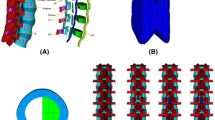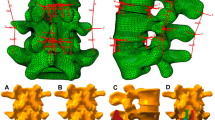Abstract
Introduction
Interspinous devices are used as an alternative to the current gold standard treatment, decompressive surgery with or without fusion, for lumbar spinal stenosis. They are supposed to limit extension and expand the spinal canal and foramen at the symptomatic level, but still allow lateral bending and axial rotation in the motion segment. The aim of the present study is the biomechanical evaluation of the change in the range of motion of the affected and adjacent segments following implantation of different interspinous devices under load in all directions of motion.
Method
Eight fresh frozen human cadaver lumbar spines (L2–L5) were tested in a spinal testing device with a moment of 7.5 nm in flexion/extension, lateral bending and rotation with and without a preload (follower load of 400 N). The ROM was measured after implantation of Aperius® (Kyphon, Mannheim), In-Space® (Synthes, Umkirch), X-Stop® (Tikom, Fürth) and Coflex® (Paradigm Spine, Wurmlingen) into the segment L3/L4.
Results
All interspinous devices caused a significant reduction in extension of the instrumented segment without significantly affecting the other directions of motion. The flexion was reduced by all implants only when the follower load was applied. All devices caused a higher ROM of the whole spine during lateral bending and rotation.
Conclusion
The actual evaluated interspinous devices led to a significant reduction in ROM during flexion–extension, but to a significant increase in ROM for the whole specimen (L2–L5) during lateral bending and rotation, which could increase the risk of adjacent segment degeneration.






Similar content being viewed by others
References
Amundsen TH, Weber F (1995) Lumbar spinal stenosis. Clinical and radiologic features. Spine 20:1178–1186
Axelsson P Jr, Stromqvist B (2007) Adjacent segment hypermobility after lumbar spine fusion: no association with progressive degeneration of the segment 5 years after surgery. Acta Orthop 78:834–839
Bastian L, Lange U, Knop C et al (2001) Evaluation of the mobility of adjacent segments after posterior thoracolumbar fixation: a biomechanical study. Eur Spine J 10:295–300
Bono CM, Vaccaro AR (2007) Interspinous process devices in the lumbar spine. J Spinal Disord Tech 20(3):255–261
Bowers C, Amini A, Dailey AT, Schmidt MH (2010) Dynamic interspinous process stabilization: review of complications associated with the X-Stop device. Neurosurg Focus 28(6):E8
Cheh G, Bridwell KH, Lenke LG, Buchowski JM, Daubs MD, Kim Y, Baldus C (2007) Adjacent segment disease following lumbar/thoracolumbar fusion with pedicle screw instrumentation: a minimum 5-year follow-up. Spine 32:2253–2257
Chow DH, Luk KD, Evans JH et al (1996) Effects of short anterior lumbar interbody fusion on biomechanics of neighboring unfused segments. Spine 21:549–555
Cunningham BW, Kotani Y, McNulty PS et al (1997) The effect of spinal destabilization and instrumentation on lumbar intradiscal pressure: an in vitro biomechanical analysis. Spine 22:2655–2663
Deyo RA, Gray DT, Kreuter W, Mirza S, Martin BI (2005) United States trends in lumbar fusion surgery for degenerative conditions. Spine 30:1441–1445
Goel VK, Panjabi MM, Patwardhan AG, Dooris AP, Serhan H (2006) American Society for Testing and Materials. Test protocols for evaluation of spinal implants. J Bone Joint Surg Am 88(Suppl. 2):103–109
Hilibrand AS, Robbins M (2004) Adjacent segment degeneration and adjacent segment disease: the consequences of spinal fusion? Spine J 4:190S–194S
Inufusa A, An HS, Lim TH et al (1996) Anatomic changes of the spinal canal and intervertebral foramen associated with flexion–extension movement. Spine 21:2412–2420
Jönsson B, Annertz M, Sjöberg C et al (1997) A prospective and consecutive study of surgically treated lumbar spinal stenosis: II: five-year follow-up by an independent observer. Spine 22:2938–2944
Katz JN, Lipson SJ, Chang LC, Levine SA, Fossel AH, Liang MH (1996) Seven- to 10-year outcome of decompressive surgery for degenerative lumbar spinal stenosis. Spine 21:92–98
Kuchta J, Sobottke R, Eysel P, Simons P (2009) Two-year results of interspinous spacer (X-Stop) implantation in 175 patients with neurologic intermittent claudication due to lumbar spinal stenosis. Eur Spine J 18(6):823–829
Kumar MN, Jacquot F, Hall H (2001) Long-term follow-up of functional outcomes and radiographic changes at adjacent levels following lumbar spine fusion for degenerative disc disease. Eur Spine J 10:309–313
Lindsey DP, Swanson KE, Fuchs P et al (2003) The effects of an interspinous implant on the kinematics of the instrumented and adjacent levels in the lumbar spine. Spine 28:2192–2197
Miller JD, Miller MC, Lucas MG (2010) Erosion of the spinous process: a potential cause of interspinous process spacer failure. J Neurosurg Spine 12:210–213
Olsewski JM, Schendel MJ, Wallace LJ et al (1996) Magnetic resonance imaging and biological changes in injured intervertebral discs under normal and increased mechanical demands. Spine 21:1945–1951
Panjabi MM (1988) Biomechanical evaluation of spinal fixation devices: I A conceptual framework. Spine 13(10):1129–1134
Panjabi MM (2007) Hybrid multidirectional test method to evaluate spinal adjacent-level effects. Clin Biomech (Bristol, Avon) 22(3):257–265
Park P, Garton HJ, Gala VC, Hoff JT, McGillicuddy JE (2004) Adjacent segment disease after lumbar or lumbosacral fusion: review of the literature. Spine 29:1938–1944
Patwardhan AG, Havey RM, Meade KP et al (1999) A follower load increases the load-carrying capacity of the lumbar spine in compression. Spine 24(10):1003–1009
Phillips FM, Reuben J, Wetzel FT (2002) Intervertebral disc degeneration adjacent to a lumbar fusion. An experimental rabbit model. J Bone Joint Surg Br 84:289–294
Porter RW (1996) Spinal stenosis and neurogenic claudication. Spine 21:2046–2052
Richards JC, Majumdar S, Lindsey DP et al (2005) The treatment mechanism of an interspinous process implant for lumbar neurogenic intermittent claudication. Spine 30:744–749
Richter A, Schütz C, Hauck M, Halm H (2009) Does an interspinous device (Coflex) improve the outcome of decompressive surgery in lumbar spinal stenosis? One-year follow up of a prospective case control study of 60 patients. Eur Spine J [Epub ahead of print]
Schlegel JD, Smith JA, Schleusener RL (1996) Lumbar motion segment pathology adjacent to thoracolumbar, lumbar and lumbosacral fusions. Spine 21:970–981
Schmoelz W, Huber JF, Nydegger T, Dipl I, Claes L, Wilke HJ (2003) Dynamic stabilization of the lumbar spine and its effects on adjacent segments: an in vitro experiment. J Spinal Disord Tech 16(4):418–423
Schultz A (1987) Loads on the lumbar spine. In: Jayson MIV (ed) The lumbar spine and back pain. Churchill Livingstone, Edinburgh, pp 204–214
Seitsalo S, Schlenzka D, Poussa M, Osterman K (1997) Disc degeneration in young patients with isthmic spondylolisthesis treated operatively or conservatively: a long-term follow-up. Eur Spine J 6:393–397
Sénégas J, Vital JM, Pointillart V, Mangione P (2009) Clinical evaluation of a lumbar interspinous dynamic stabilization device (the Wallis system) with a 13-year mean follow-up. Neurosurg Rev 32(3):335–341
Siddiqui M, Nicol M, Karadimas E et al (2005) The positional magnetic resonance imaging changes in the lumbar spine following insertion of a novel interspinous process distraction device. Spine 30:2677–2682
Siddiqui M, Smith FW, Wardlaw D (2007) One-year results of X-Stop interspinous implant for the treatment of lumbar spinal stenosis. Spine 32(12):1345–1348
Simotas AC, Dorey FJ, Hansraj KK, Cammisa F Jr (2000) Nonoperative treatment for lumbar spinal stenosis. Clinical and outcome results and a 3-year survivorship analysis. Spine 25(2):197–220
Sobottke R, Koy T, Röllinghoff M, Siewe J, Kreitz T, Müller D, Bangard C, Eysel P (2010) Computed tomography measurements of the lumbar spinous processes and interspinous space. Surg Radiol Anat 32(8):731–738
Swanson KE, Lindsey DP, Hsu KY, Zucherman JF, Yerby SA (2003) The effects of an interspinous implant on intervertebral disc pressures. Spine 28(1):26–32
Turner JA, Ersek M, Herron L et al (1992) Surgery for lumbar spinal stenosis. Attempted meta-analysis of the literature. Spine 17:1–8
Verbiest H (1954) A radicular syndrome from developmental narrowing of the lumbar vertebral canal. J Bone Joint Surg Br 36:230–237
Wai EK, Santos ER, Morcom RA, Fraser RD (2006) Magnetic resonance imaging 20 years after anterior lumbar interbody fusion. Spine 31:1952–1956
Willén J, Danielson B, Gaulitz A et al (1997) Dynamic effects on the lumbar spinal canal: axially loaded CT-myelography and MRI in patients with sciatic and/or neurogenic claudication. Spine 22:2968–2976
Wilke HJ, Wenger K, Claes L (1998) Testing criteria for spinal implants: recommendations for the standardization of in vitro stability testing of spinal implants. Eur Spine J (7):148–154
Wilke HJ, Drumm J, Häussler K, Mack C, Steudel WI, Kettler A (2008) Biomechanical effect of different lumbar interspinous implants on flexibility and intradiscal pressure. Eur Spine J (8):1049–1056
Wiseman CM, Lindsey DP, Fredrick AD, Yerby SA (2005) The effect of an interspinous process implant on facet loading during extension. Spine 30(8):903–907
Zucherman JF, Hsu KY, Hartjen CA, Mehalic TF, Implicito DA, Martin MJ, Johnson DR 2nd, Skidmore GA, Vessa PP, Dwyer JW, Puccio S, Cauthen JC, Ozuna RM (2004) A prospective randomized multi-center study for the treatment of lumbar spinal stenosis with the X STOP interspinous implant: 1-year results. Eur Spine J 13(1):22–31
Acknowledgments
The authors would like to thank the Institute of Medical Biostatistics, Epidemiology and Informatics of the University Medical Center of the Johannes Gutenberg University Mainz for their help with the statistical analysis of this study.
Author information
Authors and Affiliations
Corresponding author
Rights and permissions
About this article
Cite this article
Hartmann, F., Dietz, SO., Hely, H. et al. Biomechanical effect of different interspinous devices on lumbar spinal range of motion under preload conditions. Arch Orthop Trauma Surg 131, 917–926 (2011). https://doi.org/10.1007/s00402-010-1235-8
Received:
Published:
Issue Date:
DOI: https://doi.org/10.1007/s00402-010-1235-8




